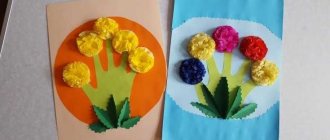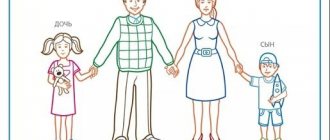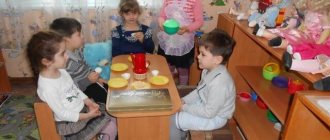Emotionally positive, meaningful communication with people around is the most important condition for the full development of a child.
Teacher's tasks:
- Develop a friendly attitude of children towards loved ones - love for parents, affection and trust in the teacher, sympathy for peers;
- Awaken children’s emotional responsiveness to the state of loved ones, peers, as well as fairy tale characters, animals and the desire to help - to have pity, to console, to say a kind word;
— Help children master different ways of interacting with adults and peers in play, in everyday communication and everyday activities; »
— Gradually accustom children to follow the basic rules of a culture of behavior;
— Develop the ability to convey different emotional states in imitation-figurative games, empathize with the mood of peers in common affairs, games, activities, joint holidays;
— Enrich children’s ideas about people (adults and peers), about the features of their appearance, gender differences, about pronounced emotional states, about the kind deeds of people, about family and family relationships.
Child and adults
Third year of life
Concepts and cognitive skills
Adults. Show interest in adults and their actions. Distinguish and name adults in life and in pictures. Show, name the main parts of the body, a person’s face, his actions. Distinguish and name individual actions of adults in which a kind attitude towards children is manifested (feeding, dressing, caressing).
Emotional states.
Together with the teacher, look at pictures and toys with a pronounced emotional state (laughing, crying). Distinguish contrasting emotional states (laughter, tears) by facial expressions. Repeat after the teacher words denoting the corresponding emotional state (“Uncle laughs,” “Mom laughs”) and show this state in pictures. Distinguish between emotional states that the teacher emphatically demonstrates through facial expressions, gestures, intonation of voice, actions and quickly stops them, moves on to new toys and just as quickly leaves the game without developing the plot.
Family.
Together with the teacher, look at pictures depicting a family - children and parents. Show where mom, dad, and children are. Show and name in pictures actions in which parents’ care for their children is manifested (mom ties a beautiful bow, dad gives a car, etc.).
With the help of the teacher, highlight in the pictures and in life the facts of the kind attitude of children towards adults (the child hands Grandfather slippers, hugs his mother).
Average.
Game actions are varied. The child reflects a plot from several actions related in meaning. Willingly plays with the teacher, reproduces game actions and speech of the teacher in independent play. Accepts the offer to use substitute items in the game, uses them in games. In simulation games, it expressively conveys the game image. Watches with interest the play actions of other children, joins in the game with peers, but experiences difficulties in coordinating play actions. Names his playing role.
High. The child reflects different stories in games. Independently uses substitute objects. Names his game role and game actions. When playing with a teacher, he enters into a game situation, shows game initiative, and joins in the game dialogue with interest. In individual play he speaks a lot out loud and changes his voice intonation. Willingly communicates with children and makes suggestions for games. Names favorite games. Knows the rules of familiar games well.
Practical skills, behavior, communication. Upon the encouragement and demonstration of elders, show kindness to loved ones: fulfill individual requests, repeat the actions shown, participate in a joint game. At the initiative of an adult, enter into communication: answer questions about yourself (“What is your name?”), about family members (“Where is mom?”, “What is dad’s name?”), about favorite toys.
Participate together with adults in good deeds (feed animals, give a gift). By showing and encouraging an adult to show responsiveness to the condition of adults (to have pity, to hug, to caress).
Following the example and reminder of the teacher, use affectionate words - addresses to loved ones (“granny”, “mommy”, etc.), say “thank you”. Rejoice in the approval of your elders.
Fourth year of life
Concepts and cognitive skills
Adults.
Recognize and name adults in life and in pictures. Highlight features of appearance. hairstyles, clothes, shoes of adults; understand the differences between adults by gender (father, mother, aunt, uncle, grandfather, grandmother). When comparing pictures depicting adults, separate pictures depicting men from pictures depicting women (“Here is aunt and here is aunt. Here are grandmothers, and here are grandfathers”).
With the help of a teacher! in pictures, in fairy tales, in life, highlight the actions and actions of adults, in which their concern for others is manifested - about children, about animals. Highlight individual actions in which the kind attitude of children towards adults, towards parents, towards the teacher is manifested.
Emotional states. Together with the teacher, look at pictures depicting pronounced emotional states of people (joy, fun, tears, anger), corresponding facial expressions, gestures; associate an emotional state with certain actions and words of an adult. Arrange the pictures according to the general emotional state of the characters (“Here mom laughs, grandma laughs. Here grandpa doesn’t laugh”).
Family.
Look at pictures of a family, name family members and their actions. Highlight the general joyful mood of family members, its reason (everyone is laughing, there is a holiday in the family, everyone is meeting Santa Claus). Make a family out of paper figures or toys (“This is dad, mom, children”).
Arranging a room for the family: placing furniture, dishes. Answer questions about your family, how the family helps each other.
Understand that other children also have their own family, parents, that parents and children love each other and take care of each other.
Practical skills, behavior, communication. Show affection for loved ones, be able to follow the example of an adult or independently express goodwill: fulfill an adult’s request, repeat actions approved by an adult, show your skills, read a poem, sing a song. In response to an adult’s request, try to restrain negative impulses: do not scream loudly, do not whine.
Following the example of the teacher, try to call elders by “you”, and the teacher by name and patronymic. Do not turn away from an adult if he speaks; answer questions about parents, favorite toys, and individual events in kindergarten.
Willingly engage in joint games or other activities with an adult.
Following the example of elders, notice the mood of family members and react to it accordingly (“Grandma fell asleep - you can’t make noise”).
Encouraged by elders to do something good for loved ones: give flowers to the teacher, bring glasses to grandfather, show your toys to grandmother.
In kindergarten, as a reminder and independently, say hello, goodbye, thank you.
Child and peers
Third year of life
Concepts and cognitive skills
Children.
Distinguish, recognize, name children in pictures and in life. Show and name their actions, recognize and call children in the group by name. Emotional states.
Show interest in children's facial expressions; name parts of the face. Together with the teacher, look at pictures depicting the pronounced emotional states of children. Name the pronounced emotional state of a peer (laughs, rejoices, cries).
Relationship. Together with the teacher, look at pictures depicting positive actions and actions of children towards each other (playing together, picking berries, helping to carry a large box) and good deeds of children (feeding animals, petting a cat, bathing a doll).
At the teacher’s suggestion, pay attention to the good actions and deeds of the children in the group (Olya and Yana play together with the ball. Sasha helps Vika put on her fur coat). Show interest in common activities with peers and in the play activities of other children. Ask the teacher or other children about their actions and names.
Practical skills, behavior, communication.
By demonstration or encouragement of the teacher to show kindness towards peers (share a toy, give a treat).
Show interest in communicating with children, call familiar children by name; when shown by the teacher, engage in games with a common toy. Willingly participate in round dance games (“Who is good with us”, “Loaf”), in imitation games (“Merry bunnies”, “Snowflakes are spinning”, “Sunshine”). Be able to respond to. general emotional state: enjoying joint activities, games, dancing, music.
Following the example of the teacher, show sympathy for your peer (take pity, take the hand, offer sweets). In communication, by showing and reminding adults, affectionately call by name (Olechka, Lenochka).
Following the example of the teacher, show a kind attitude towards toys and animals (“do not offend” dolls, do not frighten animals).
Participate in situations that unite children with a common goal and a common result of activity (collect autumn leaves into a common bouquet, pour a large “mountain” out of sand, make koloboks for treating dolls, glue your flower to a common “clearing”, etc.).
Fourth year of life
Concepts and cognitive skills
Children.
Know the features of the appearance of children (face, hairstyle, clothes, shoes), differences between children based on gender (boy, girl). Know the names of boys and girls.
Emotional states.
Look at pictures depicting children’s vivid emotional states; with the help of the teacher, draw a conclusion about the state the children are experiencing (they are happy, laughing, scared, crying). Be able to select pictures depicting the same emotional states (“Everyone is laughing here”).
Understand the connection between appropriate emotional states and children's actions. Understand that if someone is crying or upset, you need to come up and calm him down.
Distinguish between cheerful and sad music, cheerful and sad moods of children and animals (“Children play with kittens - everyone is having fun”).
Relationship. Know that in kindergarten children address each other by name, speak friendly, show attention to each other, / share toys. Understand what actions towards peers earn the approval of adults. (It’s good when a child treats another, comforts him if he is offended.) Represent certain actions that are not approved and prohibited by adults in relation to children. (You cannot offend or cause pain to others.)
Looking at the pictures, try, at the request of the teacher, to imagine and reproduce how children affectionately address each other, what words they say. Select pictures depicting the good deeds of children, express your attitude towards them (“I like them. They are good children”).
Practical skills, behavior, communication.
It is up to you to call your peers by name, address them in a friendly manner. Following the example and encouragement of the teacher, show a kind attitude towards your peers: readiness for joint actions, the ability to calmly play side by side and in a small subgroup, united by a common plot of the game.
Following the prompting and example of the teacher, notice the emotional state of a peer, show sympathy, provide basic assistance (pity, console, treat, invite to a common game).
Together with peers, take part in solving problem-game situations of humanistic content created by the teacher (“Our bunny injured his paw”; “Mishutka has a sore throat”; “Let’s find a friend for the kitten Pooh”; “Let’s build a warm house for the hedgehog Thorn”; “Let’s feed the hungry monkeys”) "; "Let's calm and warm the bunny and help him find his mother"). In situations, discuss the problem, express your suggestions, help toys “in trouble.”
Willingly respond to an offer to participate in a common cause: in round dances, movement and imitation games, in collecting common “treasures” (pictures, pebbles, shells), in cleaning up toys, in preparing for the holiday. Experience the pleasure of participating in good deeds (congratulate a peer on his birthday, exchange “treasures”, meet a child after an illness with everyone, collect flowers and give them to the girls in the group, show everyone your new wind-up toy, etc.).
The child's attitude towards himself
Third year of life
Concepts and cognitive skills. Know your name. Find out the house in which he lives, the kindergarten, his group. Know your toys and things. Know your family members. Recognize yourself in the mirror, in large photos. Distinguish your toys, your things from other people's things. Ask questions about family members, about your actions, toys (“What is mom doing?”; “Where is dad?”; “Where is my teddy bear?”).
Practical skills, behavior, communication. Say your name in different versions (Olya, Olechka). Talk about yourself in the first person: “I”. Be able to express individual states and needs using speech: “I want to sleep”; "I will play". Strive for active independent action. Show persistence in mastering a difficult action (folding pyramids, trying to lace shoes, etc.). Talk about yourself with a positive feeling (“I am good”; “Tolya is good”). Feel satisfaction from the approval of an adult and strive to repeat the positive action yourself.
Fourth year of life
Concepts and cognitive skills. Know your first name, last name, gender, age. Find out the house, the apartment in which he lives, the kindergarten, the group, his teachers, the nanny. Know your family members and immediate relatives (grandparents, aunts, uncles). It’s good to know your things, recognize your toys, books, among other things. Recognize yourself and family members in the photo. Be curious. Ask questions to yourself, about your body. Become aware of individual skills and actions that have been independently mastered (“I know how to spin a spinning top myself”; “I know how to button a jacket myself”, etc.).
Practical skills, behavior, communication. Always talk about yourself in the first person - “I”. Be able to express your desires (“I want”; “I don’t want”). Be able to verbally express individual states (“I was scared”; “I was joking”; “I was tired”). Be able to express your attitude (“I love mom”; “I like this fairy tale”; “I love this song”). Express affection to loved ones and peers. Have favorite toys, objects, favorite games, fairy tales, poems. Show persistence in mastering a new action, in obtaining answers to questions of interest, and ask adults questions about the environment (“What is this for?”; “Why?”; “How?”; “Where?”). Maintain a cheerful mood, quickly overcome negative states, strive for a positive assessment of others, show trust in the world (“Everyone loves me, I’m a good boy”).


